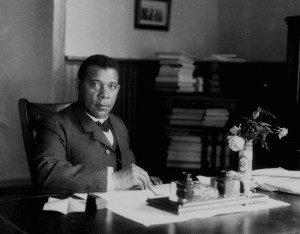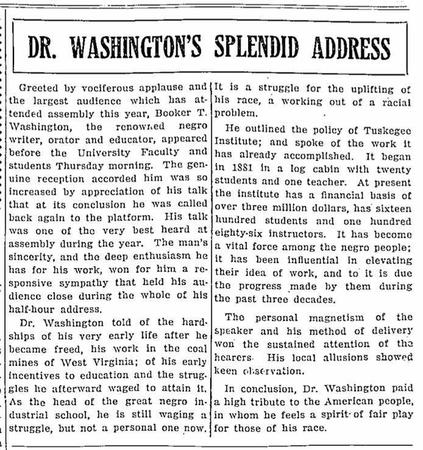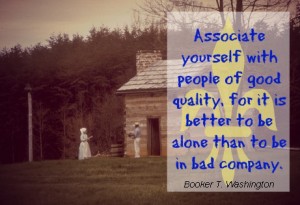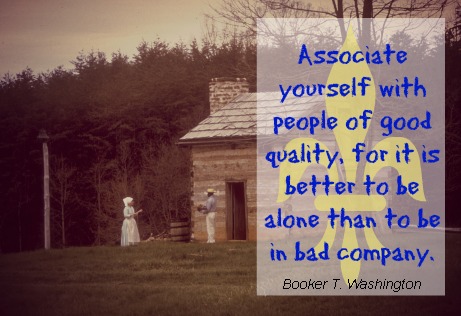It is somewhat well known that in 1863 when Charles Dickens traveled from England to New York with eight hundred Mormons aboard the ship Amazon with the intent to “bear testimony against them if they deserved it, as I fully believed they would.” But he was surprised to find them “strikingly different” from other emigrants and described them as “the pick and flower of England.”1
Less well known is Sir Arthur Conan Doyle’s visit to Utah more than thirty years after writing a book set among “sinister” and “nefarious” Mormons in Salt Lake City. He admitted that he had been misled before his visit by the writings of the time, and he apologized for his inaccurate portrayal. He wrote that he had “great respect for the Mormons.”2
 But a visit to the Mormons by prominent educator, author, orator, and presidential advisor, Booker T. Washington and what he thought about them is almost completely forgotten. This year marks the 100th anniversary of Washington’s visit to Utah and The Deseret News recently published an article describing what brought him to Utah.
But a visit to the Mormons by prominent educator, author, orator, and presidential advisor, Booker T. Washington and what he thought about them is almost completely forgotten. This year marks the 100th anniversary of Washington’s visit to Utah and The Deseret News recently published an article describing what brought him to Utah.
Booker T. Washington was the most prominent African-American of his generation. In late March 1913 he traveled to Utah to “‘get right into the midst of the Mormons to see what kind of people they are, what they look like, what they are doing, and in what respect they are succeeding.’”
After his two-day visit, he wrote a 2,000-word account for the New York Age, which was one of the most influential African-American newspapers at that time.
“‘They have certainly made the desert blossom as a rose,’” he wrote. “‘I have never been among a more intelligent, healthy, clean, progressive, moral set of people than these people are.’”
During his visit he met with African-Americans and “local leaders, attended receptions in his honor and spoke to educators.” He also spoke to a large assembly of University of Utah students, where he was “‘greeted by vociferous applause.’”
Washington said of Utah students: “‘It has been my privilege to address schools and universities in nearly every part of America, and I saw without hesitation that I have never addressed a college anywhere where the students were more alert, more responsive, more intelligent than is true of the students in these Mormon colleges.’”
 According to Max Mueller, who is writing a forthcoming paper titled “Booker T. Washington’s March 1913,” the superintendent of Salt Lake City schools visited Tuskegee Institute—the teachers college that Washington founded—and invited him to come and speak.
According to Max Mueller, who is writing a forthcoming paper titled “Booker T. Washington’s March 1913,” the superintendent of Salt Lake City schools visited Tuskegee Institute—the teachers college that Washington founded—and invited him to come and speak.
Washington’s visit was evidently in response to an invitation, a curiosity about the Mormons, and possibly a quest to obtain funding for his college.
Mueller said that Washington hoped to “‘create an independent, self-sufficient, respected community of industrious, conservative people’” and thought the Latter-day Saints were a model of that type of community. “‘The saints and African Americans actually have a shared history of exclusion from the mainstream, of persecution. So they had that in common.’”
Washington wrote:
“‘First . . . the Mormons were most inhumanly persecuted almost from the first organization of their church. This was especially true in Missouri and Illinois. Hundreds of their followers were put to death. The courts gave them little protection. The mob that either killed or wounded the Mormons was seldom, if ever, punished. . . . but out of this inhuman and unjust treatment grew the strength of these people . . .
‘The second parallel between the Mormon and the Negro is this. These people, I am sure, have been misrepresented before the world. . . . The Negro is suffering today just as the Mormons are suffering and have suffered, because people from the outside have advertised the worst in connection with Mormon life and they seldom called attention to the best in connection with the life of the Mormons.’”
 Washington’s observations are also interesting because “at that time The Church of Jesus Christ of Latter-day Saints did not allow its members of African descent to be ordained to the priesthood.” (All worthy males are ordained to the priesthood now.) And because of racially discriminatory policies of the time, Washington wasn’t allowed to stay in the prestigious Hotel Utah.
Washington’s observations are also interesting because “at that time The Church of Jesus Christ of Latter-day Saints did not allow its members of African descent to be ordained to the priesthood.” (All worthy males are ordained to the priesthood now.) And because of racially discriminatory policies of the time, Washington wasn’t allowed to stay in the prestigious Hotel Utah.
But Mormons recognized their similarities with African-Americans and often “spoke out about extralegal violence against African-Americans.”
Booker T. Washington visited Utah to “see what kind of people” the Mormons were because he knew the value of getting “right into the midst” of them:
“‘I have learned by experience and observation that it is never safe to pass final judgment upon a people until one has had an opportunity to get into the real life of these people.’”
Notes:
1. The Voyage of the Amazon: A Close View of One Immigrant Company
2. 100 years since Booker T. Washington’s historic visit to the Mormons
This article was written by Paula Hicken, a member of The Church of Jesus Christ of Latter-day Saints.
 Paula Hicken was an editor with the Neal A. Maxwell Institute for Religious Scholarship from 2000 to 2013. She earned her BA degree in English from Brigham Young University. She edited Insights, the Maxwell Institute newsletter, and was the production editor for Faith, Philosophy, Scripture, Hebrew Law in Biblical Times (2nd ed.), Third Nephi: An Incomparable Scripture, and was one of the copy editors for Analysis of the Textual Variants of the Book of Mormon. She also helped manage the Maxwell Institute intellectual property and oversaw rights and permissions. She has published in the Ensign, the Liahona, the LDS Church News, and the FARMS Review.
Paula Hicken was an editor with the Neal A. Maxwell Institute for Religious Scholarship from 2000 to 2013. She earned her BA degree in English from Brigham Young University. She edited Insights, the Maxwell Institute newsletter, and was the production editor for Faith, Philosophy, Scripture, Hebrew Law in Biblical Times (2nd ed.), Third Nephi: An Incomparable Scripture, and was one of the copy editors for Analysis of the Textual Variants of the Book of Mormon. She also helped manage the Maxwell Institute intellectual property and oversaw rights and permissions. She has published in the Ensign, the Liahona, the LDS Church News, and the FARMS Review.
Additional Resources:
About paulah
Paula Hicken was an editor with the Neal A. Maxwell Institute for Religious Scholarship from 2000 to 2013. She earned her BA degree in English from Brigham Young University. She edited Insights, the Maxwell Institute newsletter, and was the production editor for Faith, Philosophy, Scripture, Hebrew Law in Biblical Times (2nd ed.), Third Nephi: An Incomparable Scripture, and was one of the copy editors for Analysis of the Textual Variants of the Book of Mormon. She also helped manage the Maxwell Institute intellectual property and oversaw rights and permissions. She has published in the Ensign, the Liahona, the LDS Church News, and the FARMS Review.
Twitter •


 Watch a video about the restoration of the gospel on lds.org
Watch a video about the restoration of the gospel on lds.org